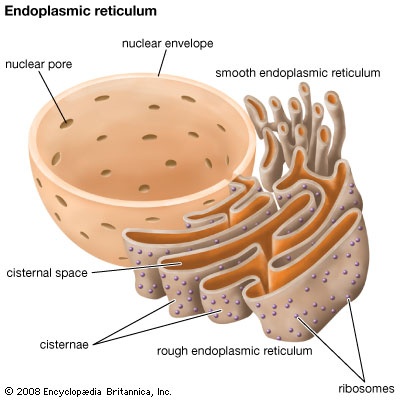ribosome
cytology
 tiny particle that is present in large numbers in all living cells and serves as the site of protein synthesis. Ribosomes occur both as free particles in prokaryotic and eukaryotic cells and as particles attached to the membranes of the endoplasmic reticulum in eukaryotic cells. Ribosomes can vary in size, although an average ribosome measures about 200 angstroms in diameter and consists of about 40 percent protein and 60 percent RNA. Ribosomes are usually made up of three or four RNA molecules and anywhere from 40 to 80 different proteins. In shape the ribosome is composed of two subunits, a larger one and a smaller one, each of which has a characteristic shape. Ribosomes are very numerous in a cell and account for a large proportion of its total RNA.
tiny particle that is present in large numbers in all living cells and serves as the site of protein synthesis. Ribosomes occur both as free particles in prokaryotic and eukaryotic cells and as particles attached to the membranes of the endoplasmic reticulum in eukaryotic cells. Ribosomes can vary in size, although an average ribosome measures about 200 angstroms in diameter and consists of about 40 percent protein and 60 percent RNA. Ribosomes are usually made up of three or four RNA molecules and anywhere from 40 to 80 different proteins. In shape the ribosome is composed of two subunits, a larger one and a smaller one, each of which has a characteristic shape. Ribosomes are very numerous in a cell and account for a large proportion of its total RNA.Ribosomes are the sites at which information carried in the genetic code is converted into protein molecules. Ribosomal molecules of messenger RNA (mRNA) determine the order of transfer RNA (tRNA) molecules that are bound to triplets of amino acids (codons). The order of tRNA molecules ultimately determines the amino acid sequence of a protein because molecules of tRNA catalyze the formation of peptide bonds between the amino acids, linking them together to form proteins. The newly formed proteins detach themselves from the ribosome site and migrate to other parts of the cell for use.
- Waals, Johannes Diederik van der
- Wabag
- Wabana
- Wabar Craters
- Wabash
- Wabash River
- Waccho
- Wace
- Wach, Joachim
- Wachsmann, Konrad
- wacke
- Wackenroder, Wilhelm Heinrich
- Wackernagel, Jacob
- Waco
- Wacław Berent
- Wacław Potocki
- Wacław Sierpiński
- wad
- Wadai
- Waddenzee
- Waddington, C.H.
- Waddington, William Henry
- Wade, Benjamin F.
- Wade-Davis Bill
- Wade-Giles romanization